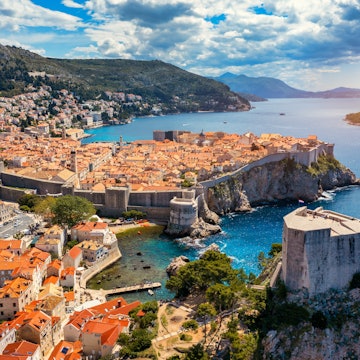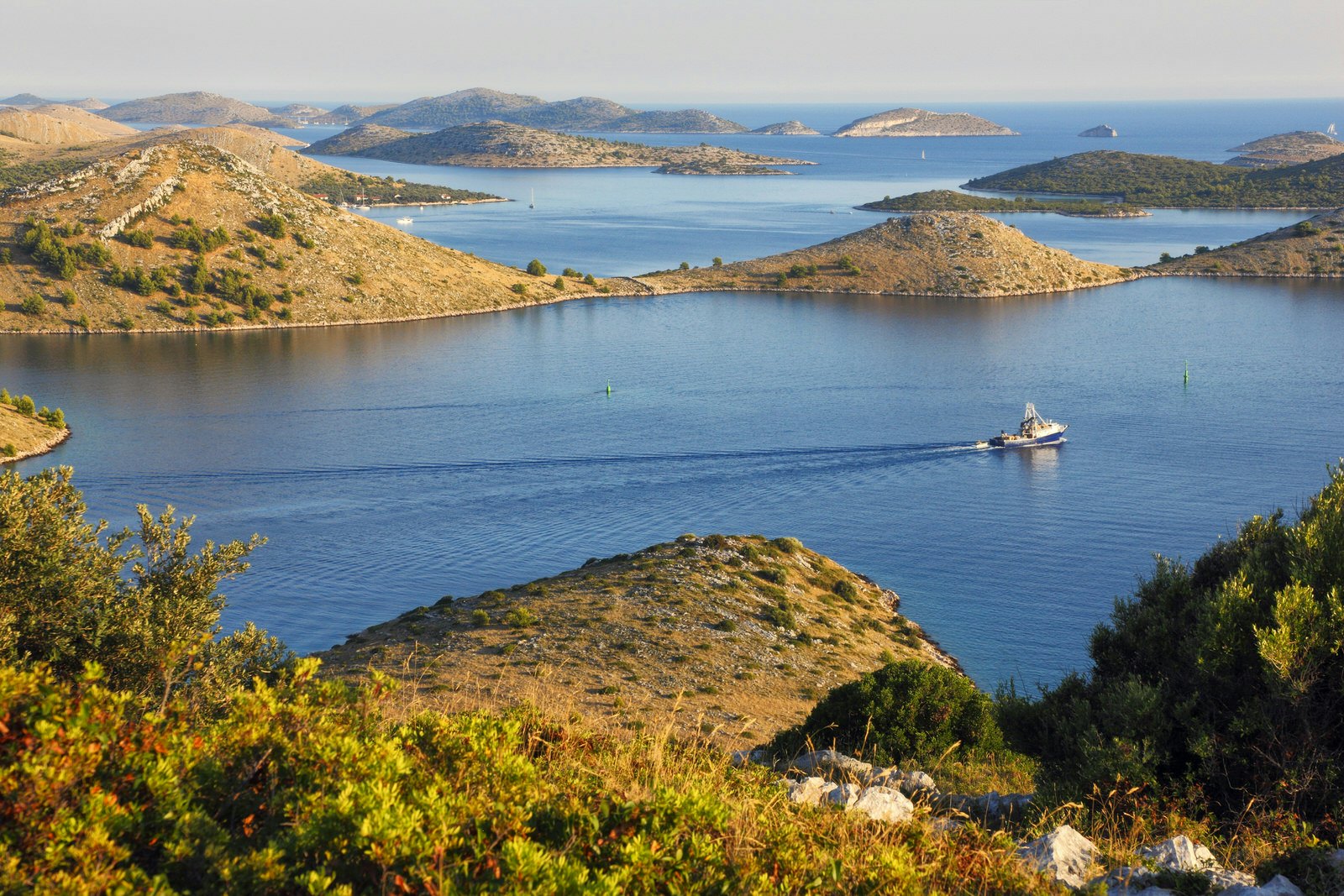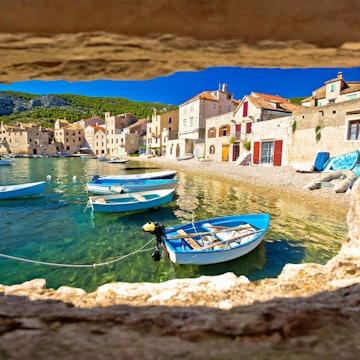

Set atop a pretty promontory that extends into the Adriatic sea, Zadar has a compact and attractive old town of golden-hued churches and Roman ruins that sits against a stirring backdrop of dramatic limestone mountains and distant scattered islands.
Less touristy than the other main Dalmatian coast hubs of Dubrovnik and Split, Zadar is a vibrant city with lively nightlife and an exciting culinary scene. The city also serves as a launchpad for excursions to remote offshore islands and beautiful national parks.

Soak up the haunting sounds of the Sea Organ
There’s nowhere on earth quite like Zadar’s Sea Organ. The inspired work of local architect Nikola Bašić, the Sea Organ channels the waters of the Adriatic through cleverly conceived subterranean pipes and whistles to produce a haunting soundtrack. Wander out to the tip of Zadar’s peninsula, sit upon the stone steps and listen as tides, swells and the gentle rise and fall of water create a constantly changing catalogue of sounds, at once melancholy and wistful, that evokes the exhalations of whales and the deeply felt sighs of Mother Earth. Better still, make your own contribution by jumping in for a swim.

Bask in the glow of the Sun Salutation
After the success of his Sea Organ, Nikola Bašić created the Sun Salutation, a 22m-diameter circle of 300 multilayered glass plates, which soaks up the sun’s energy by day and transforms the waterfront by night. Think of it as a solar experiment, one where the functional (the power gathered keeps the harbourside promenade alight) coexists with a form of elemental wonder (the resulting light show takes those who watch on a journey through the solar system). People start gathering atop the glass as the sun dips below the horizon.

Explore the emerald waters of Plitvice Lakes National Park
The forested hills, waterfalls and lakes of deep blue that comprise the Plitvice Lakes National Park make a long but infinitely rewarding day trip from Zadar. Kozjak Lake, the park’s largest, is the perfect introduction, and the path along its eastern shore leads to smaller lakes, rich in forests, grottoes, steep cliffs and waterfalls. Highlights include emerald Milanovac Lake, the viewpoint from the open-topped cavern of Šupljara, and Veliki Slap, Croatia’s tallest waterfall. To make this trip, you’ll need your own wheels, unless you join one of the tours offered by Zadar agencies.

Immerse yourself in Zadar’s nightlife scene
There are few finer places to be on a summer’s evening than one of the bars that sprawl across the flagstones of Zadar's old town, sipping Croatian wine while a sea breeze drifts in from the Adriatic. For a slice of sophistication, Varoš neighbourhood, on the southwestern fringe of the old town, has cafe-bars popular with creative types, while La Bodega, close at hand, is a temple to Croatian wines. But to capture the essence of Zadar cool, recline atop the old city walls at Garden Lounge, a chilled-out bar with waterside views, secluded alcoves, billowing fabrics and a downtempo, Ibiza-esque soundtrack.

Follow in the footsteps of the Romans
In Roman Zadar, some 2000 years ago, the Forum was the city’s major meeting place, and so it remains today. Here you can rest in the shadow of a Roman column, which, during the Middle Ages, was a shame post where wrongdoers were chained and publicly humiliated, and trace the outline of altars topped with hollows that would have caught the blood from live sacrifices. Nearby, the Museum of Ancient Glass is filled with Roman urns and amulets, jewellery and jars, while in the Archaeological Museum, there’s a 2.5m-high marble statue of Augustus and a scale model of the Forum.

Develop a taste for the local cuisine
By returning to the city’s roots – fresh fish and a focus on locally produced ingredients – Zadar has positioned itself at the heart of Croatia’s burgeoning culinary scene. In restaurants such as Foša and Kaštel, track down local ingredients such as delicate truffles that add intensity to creamy pasta dishes, or platters of tangy sheep cheese from Pag Island and wafer-thin slices of pršut (Croatian prosciutto ham), cured and dried in the salty Adriatic winds. To fully immerse yourself in the food culture of the region, take a tour or cooking class with Wine & Food Hedonism, where you’ll learn the art of cooking the Dalmatian speciality peka (stew baked in a fireplace under a bell-shaped lid) and taste delicious local wines and olive oils.

Take a boat trip to the Kornati Islands
The stark, rugged limestone so emblematic of the northern Dalmatian coast finds perfection in the Kornati Islands. Cliffs and coves, grottoes and reefs – all are features of a day-long boat excursion that begins and ends in Zadar and explores another world in between. The islands, uninhabited, rise in jagged ramparts and improbable formations that watch over turquoise seas. En route, Telašćica Bay is like the Kornatis in miniature – eerie, soulful and impossible to take your eyes off.
Gaze upon St Simeon’s dazzling golden coffin
The modest exterior of St Simeon’s Church is mere prelude to one of the most extraordinary pieces of religious iconography in the Balkans – the sarcophagus of St Simeon, a glorious, gilded extravagance of cedar, gold and silver. Linger over details in the coffin’s reliefs that depict everything from stories from the lives of Jesus and the saints to a real-life royal visit to Zadar. Other churches whose exterior more faithfully showcases Zadar’s distinctive grey-stone architectural style, including the 13th-century St Anastasia's Cathedral and 9th-century St Donatus' Church, are a short walk away to the northwest.

Sample Pag Island’s award-winning cheese
Away to Zadar’s north, Pag Island is a day trip custom made for foodies. The island’s distinctive paški sir (Pag cheese) is a national, much-awarded culinary icon, its salty, sharp taste derived from the salty herbs the island’s 35,000 free-range sheep graze on. It's a favourite at Croatian weddings, where it's served with pršut and Croatian wine. You’ll find ample opportunities to taste paški sir in Pag's restaurants, but the quiet little village of Kolan is the island’s cheese capital. Sirana Gligora runs excellent tours and tastings and has a fabulous cheese shop, while Konoba Figurica does a fabulous cheese platter.
Experience July’s Full Moon Festival
On the night of the full moon in July, there is magic in Zadar’s air. As part of a festival known locally as Noć Punog Miseca, torches, candles and lanterns light the waterfront as they must have done in centuries past, while similarly lit boats, bobbing on the water, serve up local delicacies and fresh seafood in the manner of a floating market. It’s a splendid night on which to visit the city.
https://shop.lonelyplanet.com/products/lonely-planets-best-in-travel-paperback-2019














